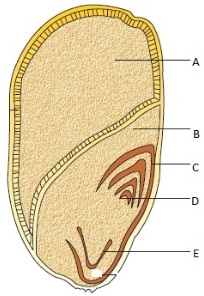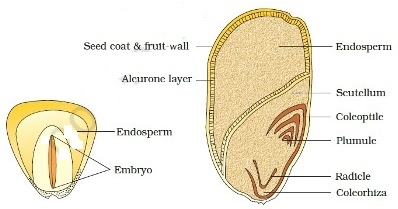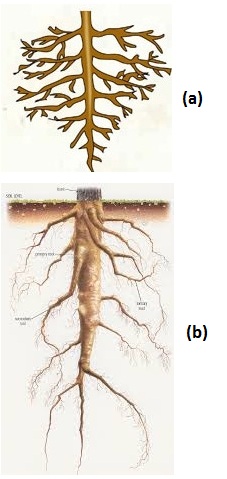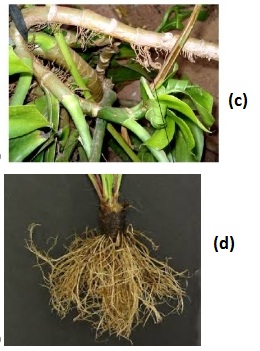CBSE Class 11 Biology – MCQ and Online Tests – Unit 5 – Morphology of Flowering Plants
Every year CBSE schools conducts Annual Assessment exams for 6,7,8,9,11th standards. These exams are very competitive to all the students. So our website provides online tests for all the 6,7,8,9,11th standard’s subjects. These tests are also very effective and useful for those who preparing for any competitive exams like Olympiad etc. It can boost their preparation level and confidence level by attempting these chapter wise online tests.
These online tests are based on latest CBSE syllabus. While attempting these our students can identify the weak lessons and continuously practice those lessons for attaining high marks. It also helps to revise the NCERT textbooks thoroughly.
CBSE Class 11 Biology – MCQ and Online Tests – Unit 5 – Morphology of Flowering Plants
Question 1.
In banana, the stem is
(a) underground only
(b) both underground and aerial
(c) absent
(d) aerial only
Answer
Answer: (a) underground only
Question 2.
Srem modified to perform the function of a leaf and having many internodes is called as
(a) phylloclade
(b) cladode
(c) offset
(d) phyllode
Answer
Answer: (a) phylloclade
Question 3.
Label the parts of a monocot seed.
(a) A.Endosperm, B. Scutellum, C. Radicle, D. Coleoptile, E. Plumule
(b) A.Endosperm, B. Coleoptile, C. Scutellum, D. Radicle, E. Plumule
(c) A.Endosperm, B. Scutellum, C. Coleoptile, D. Radicle, E. Plumule
(d) A.Endosperm, B. Scutellum, C. Coleoptile, D. Plumule, E. Radicle
Answer
Answer: (d) A.Endosperm, B. Scutellum, C. Coleoptile, D. Plumule, E. Radicle
Explanation:
Question 4.
Exceptional roots of Cuscuta are
(a) haustorial
(b) coralloid
(c) mucorhizal
(d) all of the above
Answer
Answer: (a) haustorial
Question 5.
The petiole is swollen and spongy in
(a) Nepenthes
(b) Trapa
(c) Clematis
(d) all of the above
Answer
Answer: (b) Trapa
Question 6.
Which one of the following plants dose not have root – pockets
(a) Pistia
(b) Lemna
(c) Ficus
(d) Eichhornia
Answer
Answer: (c) Ficus
Question 7.
The largest petal overlaps the lateral ones in _________ aestivation.
(a) Papilionaceous
(b) Valvate
(c) Twisted
(d) Imbricate
Answer
Answer: (a) Papilionaceous
Explanation:
In pea and bean flowers, there are five petals, the largest overlaps the two lateral petals which in turn overlaps the two smallest anterior petals. This is called Vexillary or papilionaceous aestivation.
Question 8.
In Lathyrus, the leaves are modified into
(a) thorns
(b) cladodes
(c) tendrils
(d) spines
Answer
Answer: (c) tendrils
Question 9.
Potato tuber is an underground stem because
(a) it lacks chlorophyll
(b) it is swollen
(c) it possesses axillary buds
(d) it stores starch as reserve food material
Answer
Answer: (c) it possesses axillary buds
Question 10.
Floating roots are characteristic of
(a) Tinospora
(b) Jussiaea
(c) Viscum
(d) Vanda
Answer
Answer: (b) Jussiaea
Question 11.
Thors and spines are
(a) homologous organs
(b) analogous organs
(c) thron is homologous while spine is analogous
(d) spine is homologous while is analogous
Answer
Answer: (d) A
Question 12.
Which of the following picture shows fibrous root system?

Answer
Answer: (d)
Question 13.
In which of the following plants stems do not store the food material
(a) potato
(b) ginger
(c) onion
(d) colocasia
Answer
Answer: (c) onion
Question 14.
In tamarind, the pinnate leaf is
(a) bipinnate
(b) tripinnate
(c) paripinnate
(d) imparipinnate
Answer
Answer: (a) bipinnate
Question 15.
Artabotrys is a hook climber in which the hooks are modified
(a) inflorescence axis
(b) petiole
(c) roots
(d) stipules
Answer
Answer: (a) inflorescence axis
Question 16.
The arrangement of sepals or petals in floral bud is called
(a) Placentation
(b) Aestivation
(c) Bracteate
(d) Phyllotaxy
Answer
Answer: (b) Aestivation
Explanation:
The mode of arrangement of sepals or petals in floral bud with respect to the other members of the same whorl is known as aestivation.
Question 17.
The term phyllotaxy is used to describe the
(a) type of ovary in a plant
(b) mode of arrangement of leaves
(c) type of roots
(d) arrangement of sepals and petals
Answer
Answer: (b) mode of arrangement of leaves
Question 18.
Certain plants called as runners can be easily propagated. This is due to the fact
(a) they are numerous in numbers
(b) they store the ready food
(c) they lie horizontally on the soil
(d) they can produce adventitious roots quite readily at the nodes
Answer
Answer: (d) they can produce adventitious roots quite readily at the nodes
Question 19.
The coloured part of a Bougainuillea flower is the
(a) corolla
(b) calyx
(c) bracts
(d) androecium
Answer
Answer: (c) bracts
Question 20.
The axillary buds arise
(a) endogenously from the pericycle
(b) exogenously from the tissues of the shoot apex
(c) endogenously from the cambium tissues
(d) exogenously from the innermost layers of cortex
Answer
Answer: (b) exogenously from the tissues of the shoot apex














0 Comments:
Post a Comment